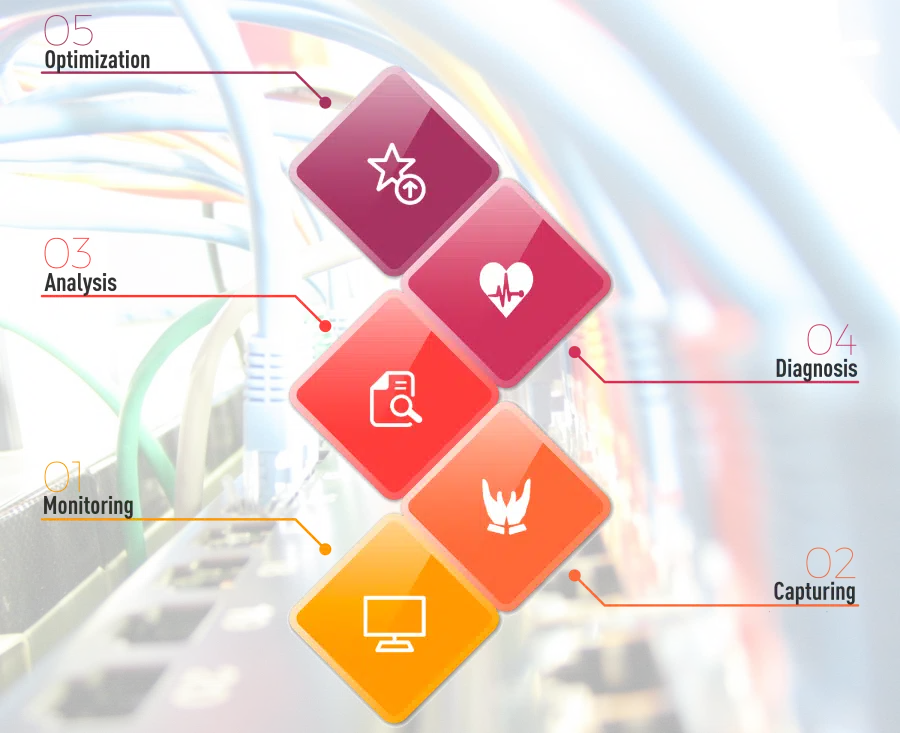The crucial steps for Network Monitoring and Analysis
A computer network consists of many different components. Its goal is to transmit data and information of any kind between the terminals in a reliable manner. To this end, it must be ensured that the transmission of this information works smoothly even when using different protocols and operating systems (Linux, Unix, Windows, Apple, Samsung, etc.)
Standards for data transmission have been developed to make this possible. In the time prior to the Internet, it was relatively easy to monitor and manage this data and the volume of data. Problems could be detected and eliminated in the local network with simple diagnostic tools.
Earlier systems used ring- and bus-based systems, making it possible to undertake diagnosis without significant technology. Today, the volume of data is exploding and backbone speeds have now reached 100Gbps.
Why do i need network analysis
Networked applications have become more critical for companies. As a result, network downtime or performance bottlenecks can have important economic consequences.
The variety of protocols and applications has also increased tremendously. In addition to this, data is no longer stored locally or centrally, but is now managed in external data centres. To conserve and make optimal use of resources, virtual machines have been established there.
Mobile broadband Internet connections have become indispensable today, which has led to many users accessing network resources via tablets, smartphones and other mobile devices from different locations. Redundant data centres, and many active network components for the protection of information are now also an important part of the IT network infrastructure.
With so many network devices and dependencies, it is not possible to guarantee 100% uptime for the infrastructure. In particular, the question arises as to how performance can be measured uniformly. If a user is affected by a shortage or a fault in the network, the symptoms may be objective, but the perceptions are clearly subjective.
NPM and APM
With so-called NPM or APM solutions you can sit back and read performance simply and easily, like the speed of a car on a speedometer. Only those who have analysed their network, knows its weaknesses and can eliminate these. Therefore, we are mainly concerned with proactive monitoring to prevent errors, bottlenecks and failures.
With a monitoring system, you can gain valuable information about your network and be alerted at any time thresholds are exceeded. Using a monitoring system can enable the early detection of problems and so give you the opportunity to eliminate them – before they affect your network performance and cause a disturbance.
Where do you get this data to analyse?
The most reliable data can only come from the cable, via which the data is transported, because the information here is genuine and you get a transparent insight into the action.
SPAN ports or capturing the data directly on the client/server can only serve for temporary purposes and is not suitable as a permanent measure. SPAN ports have technical limitations which do not allow for a reliable diagnosis. For example SPAN ports do not copy Layer 1 & 2 errors and are limited in power or bandwidth, VLAN information is discarded, and many other factors required for measurement purposes, will be lost by mirroring on the switch.
A server or client-based capture solution is also not a reliable method, since the installed network cards are not intended for such an action and read the data necessary for analysis by PCAP drivers. This may mean that the result is falsified by malicious software or impaired processes running on the client or server which impact performance significantly.
The advantages of a Network TAP
A Network TAP, once installed in the correct position, provides the necessary data in a short time and without great technical effort. You can determine the measuring points yourself through the installation of the TAPs and so you have the ability to analyse the data flexibly and independently of your desired position. So you could, for example, operate a much more detailed analysis by installing multiple TAPs and optimizing the measurement result.
When using multiple measuring points, you can evaluate important details of the network better. Thus, for example, the analysis of running time, latency and packet loss is much more accurate. We also offer a sophisticated solution for this kind of multi-segment analysis.
Our motto for a healthy Network: Monitoring > Capturing > Analysis > Diagnostics > Optimization


